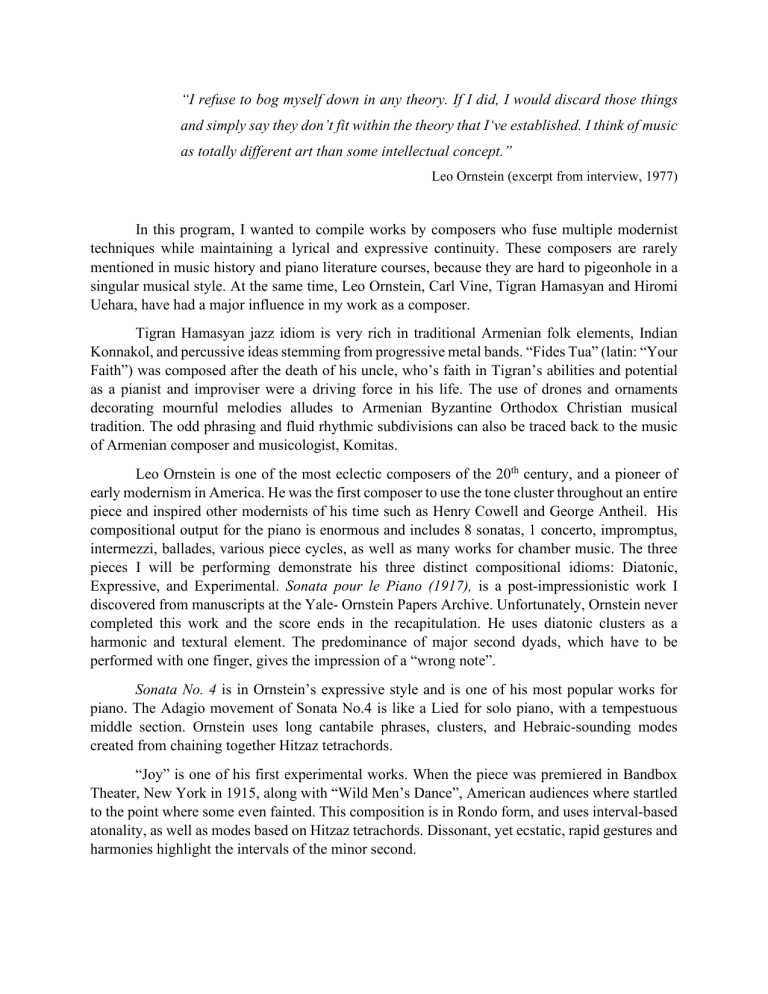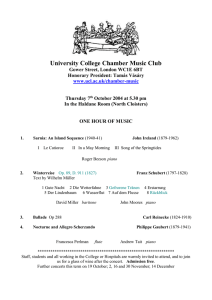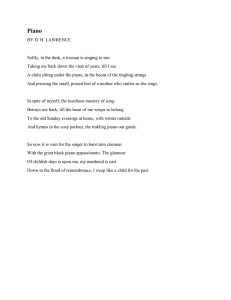
“I refuse to bog myself down in any theory. If I did, I would discard those things and simply say they don’t fit within the theory that I‘ve established. I think of music as totally different art than some intellectual concept.” Leo Ornstein (excerpt from interview, 1977) In this program, I wanted to compile works by composers who fuse multiple modernist techniques while maintaining a lyrical and expressive continuity. These composers are rarely mentioned in music history and piano literature courses, because they are hard to pigeonhole in a singular musical style. At the same time, Leo Ornstein, Carl Vine, Tigran Hamasyan and Hiromi Uehara, have had a major influence in my work as a composer. Tigran Hamasyan jazz idiom is very rich in traditional Armenian folk elements, Indian Konnakol, and percussive ideas stemming from progressive metal bands. “Fides Tua” (latin: “Your Faith”) was composed after the death of his uncle, who’s faith in Tigran’s abilities and potential as a pianist and improviser were a driving force in his life. The use of drones and ornaments decorating mournful melodies alludes to Armenian Byzantine Orthodox Christian musical tradition. The odd phrasing and fluid rhythmic subdivisions can also be traced back to the music of Armenian composer and musicologist, Komitas. Leo Ornstein is one of the most eclectic composers of the 20th century, and a pioneer of early modernism in America. He was the first composer to use the tone cluster throughout an entire piece and inspired other modernists of his time such as Henry Cowell and George Antheil. His compositional output for the piano is enormous and includes 8 sonatas, 1 concerto, impromptus, intermezzi, ballades, various piece cycles, as well as many works for chamber music. The three pieces I will be performing demonstrate his three distinct compositional idioms: Diatonic, Expressive, and Experimental. Sonata pour le Piano (1917), is a post-impressionistic work I discovered from manuscripts at the Yale- Ornstein Papers Archive. Unfortunately, Ornstein never completed this work and the score ends in the recapitulation. He uses diatonic clusters as a harmonic and textural element. The predominance of major second dyads, which have to be performed with one finger, gives the impression of a “wrong note”. Sonata No. 4 is in Ornstein’s expressive style and is one of his most popular works for piano. The Adagio movement of Sonata No.4 is like a Lied for solo piano, with a tempestuous middle section. Ornstein uses long cantabile phrases, clusters, and Hebraic-sounding modes created from chaining together Hitzaz tetrachords. “Joy” is one of his first experimental works. When the piece was premiered in Bandbox Theater, New York in 1915, along with “Wild Men’s Dance”, American audiences where startled to the point where some even fainted. This composition is in Rondo form, and uses interval-based atonality, as well as modes based on Hitzaz tetrachords. Dissonant, yet ecstatic, rapid gestures and harmonies highlight the intervals of the minor second. Nick G. Gianopoulos’ Piano Spheres Commission Sonata for Piano is an exciting twomovement work that binds this whole program together, as it very intelligently expands on compositional devices used by Ornstein and Vine, while being rooted on a distinct personal idiom. The first movement introduces harmonic ideas based on augmented fourth/major seventh chords, as well as 9-note clusters that are used thematically and cyclically. Powerful percussive elements and outcries of rage are followed by moments of intimacy and rhythmic flexibility. The second movement begins with a toccata-like homophonic modo perpetuum that is followed by a rapid tarantelle dance. The development expands on the 9-note clusters from the first movement and the coda concludes the piece with an uncontrollable torrent of notes. Carl Vine is an Australian composer that has written extensively for the piano. His Sonata (1990) is a work full of energy and lyricism, heavily inspired by dance. The work was commissioned by the Sydney Dance Company in 1991 and dedicated to the pianist Michael Kieran Harvey. It features multilayered textures, polyrhythmic ostinati, ever changing metric modulation, and an eclectic combination of clusters over simple modal melodies. The harmonic language is very rich utilizes modality, polytonality, and atonality. Vine’s notation is meticulous in pedal markings, dynamics and indications of absolute speed. Despite the lack of a unified compositional method, the score gives the impression of a composer who wants total control over the performer, almost like a serialist. When I composed “Synchronism 3:5”, my intention was to layer multiple rhythms over minimal structures and to use the piano in unpredictable ways. It is in “reverse variation” form, where each section develops 3:5 ratio ideas, while the “real” theme is stated in the end. I was inspired by the Choral et variations movement of Henri Dutilleux’s Piano Sonata, which uses a similar form. In “Synchronism 3:5”, the polyrhythm of 3 and 5 is used thematically as unfolding ostinati, contrapuntal devices, phrase lengths, and transforms each section into the next. I use the sostenuto pedal as a layering mechanism to stack dry and wet textures on top of each other. As an electric guitarist, I always wanted to transfer musical techniques such as picking, harmonic muting, hammer-on legato in the piano. I will be using a guitar thumb pick, different types of muting, as well as percussive effects such as knocking on the fallboard of the piano. These extended techniques are an accumulation of ongoing experimentations in my piano works of the past 4 years. Hiromi Uehara’s music draws effortlessly from a panorama of genres and exhibits a tremendous emotional range. Her improvisational approach is influenced by Oscar Peterson, Art Tatum and Chick Corea. What sets her apart from other jazz players is how she incorporates classical, stride, post-bebop and progressive rock in her works. “The Tom and Jerry Show” is a stride piano piece, inspired by the frenetic chase of the famous cat and mouse cartoon characters.

